Text
East Africa: Serengeti - Part 2
A Travel Journal Series
By Bonnie Kellogg

As our Land Cruiser bounces across the rugged terrain, the tires catch in the many ruts pocking the dirt road, jostling us from our lingering slumber. The air is still nippy as the sun begins its climb, and I wrap my coat around me. I consider my environment—the panorama, the noises, the light breeze brushing past my face—taking in everything. Like a vast canvas, the landscape stretches out, seemingly without a vanishing point; the Serengeti goes on and on. In the Maasai language, Serengeti means endless plains.
The setting is scrubby, dusty, comprising every shade of tan, and freckled with splotches of sage green from the scatter of thorn bushes before giving way to grassy savanna. It reminds me of a scene from an old western film. Despite my lackluster account, the Serengeti Plains holds a rustic charm. A subtle splendor.
The excitement and anticipation have me vibrating, even though I haven’t seen a single animal this morning. We’ve traveled halfway around the globe to see the wildlife who call the Serengeti home. Today, we set off on a safari.
It was a long and bumpy drive from Nairobi up the Great Rift Valley to Samburu National Park, where we spent the night in our tented accommodations. We’re a single party, traveling together. Friends. Well, we have a mutual pal, Virginia, who has brought us together, and now we’re all friends.
At the time of booking, we reserved every seat in the Land Cruiser. Today, one sits empty, taken up only by his hat. Virginia carried it with her. It was his favorite hat and would have protected him from the African sun had fate not intervened. She brought it in his memory and to help our hearts mend. Gordon should be in that seat, wearing that hat. It’s a shared sentiment.
Our grief makes the trip more meaningful. It plays out in two alternating portrayals. In one portrait, Gordon’s spirit follows us, sharing in the experience. The other is our new reality, where we carry on without our friend. There’s lots of conjecture. Oh, Gordon would enjoy this. Gordon wouldn’t like that. The truth? Gordon would have loved safari. And he wouldn’t have occupied that empty seat. Gordon would have been in the front, in the cockpit, in his dynamic, lead-the-way style, co-piloting our game drives alongside Stephen, our soft-spoken, engaging guide. Instead, I hop around the vehicle, moving from back to front, and back again, as Stephen navigates the terrain while entertaining us with stories of his family and his adventures from past trips and educating us on the flora and fauna of Africa. Stephen is a gem and a wealth of knowledge.
We’re early birds this morning. So, it’s fitting that our first wildlife spotting should be a bird. As we drive the dirt road, our lodge in the rear-view mirror, the majestic and prehistoric-looking ostrich bounds past our vehicle in long strides. He’s got to be 240cm tall. Though the feathered beauties cannot fly, they can run at speeds over 65km per hour, and their legs are impressive weapons, too. They can kick—and kill—a lion with those legs.
It isn’t long before we see throngs of animals crowding the savanna. They are of the hooved variety. Zebra, gazelle, impala, waterbuck, topi, oryx, and my favorite, the dik-dik, roam and forage.
Oh, be still my heart. And I don’t mean it in a sarcastic sense. The doe-eyed dik-diks, a pint- sized species of antelope that weighs between 3-6kg, are irresistible. Any smaller, and I might have put one in my pocket! No, officer. I have nothing to declare.

An hour later, we sit in silence, scanning the grasslands, watching for any movement that would signal an animal is passing through, concealed by the high grass, or hiding in plain sight.
Once in Australia, I saw only a field of tall grass. I must be alone, I thought. But then, eyes blinked, unmasking his camouflage. A wallaby stared back at me.
Suddenly, a yellow-colored stick pokes above the grass, the darker pads of his paw giving him away. Then another leg surfaces. Then another, until all four legs point toward the sky. His front limbs extend and then quiver, allowing for a good stretch, followed by his hind legs. The young cub, rocking on his back, is waking from his afternoon nap. Turns out, five male cubs are hiding in the grass and wake one after the other. They’re alone and undernourished. It’s a big litter, and the lioness can’t care for her large brood, Stephen tells us.
We drive a short distance before encountering an adult male lion. He is handsome, with his thick mane and commanding build. He has a ferocious roar and is a formidable hunter. He lives up to his moniker, King of the Serengeti. Is he Papa to the five cubs? Stephen tells us the pride may have up to three males, so whether he is Papa, only he knows, and he’s not telling.

We come upon a copse of trees and a tower of giraffes munching on leaves. One stops, ambles over, and positions himself in front of our vehicle, preventing us from passing. Perhaps the giraffe doesn’t appreciate the intrusion during mealtime?
It’s been a long day, and we return to our accommodations. Now, I’m not one to camp, especially in a tent. But this isn’t your typical camping. And these aren’t just any tents. Enter glamping.
It surprised and delighted me to learn of the upscale tent-style lodgings in the Serengeti. Some are quite luxurious, even romantic, à la Out of Africa. They’ve stretched camel colored canvas over posts and beams, with plenty of cut-out windows, doors, and ventilation openings that have conceal-and-reveal style flaps over mesh; the flaps block the wind and sunlight, and the mesh keeps the bugs out. It’s fantastic. We open the flaps, an invitation to the African sun, and it presents itself in a balmy, buttery glow that filters through the mesh, casting light in a checkered pattern across the floor and over the four-poster bed.
Later, we freshen up and make our way to the main lodge, which includes a reception area, open- air lounge, and an enclosed timber and glass-framed building that houses the restaurant, where breakfasts and dinners are served. We meet our friends in the lounge for drinks before dinner. After, we situate ourselves in the dining room, Gordon’s hat resting at the head of the table. We tip our glasses in salute, a farewell to our friend. Soup, salad, and a variety of barbequed meats with roasted vegetables and homemade flatbread are served. Our meal is delicious.
The drinks, dinner, and warm African air have made us sleepy. We return to our tent and tuck in, leaving the canvas flaps open, inviting in the night air. Ensconced in the netting draped over our bed, we drift into sleep to the sounds of animals and insects. We are in the middle of Kenya and the start of our Serengeti experience. Sweet dreams, indeed. This is my kind of camping!
We leave early the next day; grass will not grow under our feet in Africa. From Samburu, we travel 220km south to Ol Pejeta. Tucked below Mount Kenya, the second highest mountain in Africa after Kilimanjaro, our camp is on a watering hole that attracts plenty of activity for wildlife viewing. We take a half-day game drive, enjoy dinner, and fall into our beds. Days five through seven have us driving another 600kms from Ol Pejeta to Lake Naivasha to Masai Mara, with game drives along the way. It sounds absurd, but these voyages are tiring stuff!
Day eight, we arrive at the airstrip early. It’s nothing more than a dirt stripe slashed through grassy vegetation, punctuated by a small ramshackle building and a sign that reads: Keekorok Airstrip, Masai Mara National Reserve. With jittery nerves, we board the small plane, the first of two flights today. We duck and slide into our seats, buckling in for the short flight to the Kenyan-Tanzanian boundary, where we’ll meet a handler who will aid us in making our cross- border transfer between the two countries. The plane shudders as it bumps down the runway before takeoff. Virginia and I share a glance, a watery-eyed exchange. My stomach makes an unsettled roll, and my breath lurches. It’s my first time on a small plane since the fatal event that took my friend and Virginia’s darling husband. It’s been two months since Gordon’s single-engine Piper Cherokee crashed soon after takeoff, and the feelings are still raw. The fear real. I needed to look away or risk losing it in front of Virginia, setting her off. I blink, turn my head, and look out the window.
We arrive at Migori Airstrip and make our road transfer across the border. This exercise with immigration and customs for entry into Tanzania takes roughly an hour, after which we are driven to Tarime Airstrip for our second flight, followed by a three-hour drive to our next location to begin the second half of our Serengeti experience, Tanzanian-style.
En route to Ngorongoro Crater, we stop at the most fascinating place: Olduvai Gorge Palaeolithic site, known as the Cradle of Mankind. This is the famous archaeological site where Louis and Mary Leakey, among others, first made, documented, and archived their discoveries of early human evolution, the fossil hominids, and traces of stones fashioned as tools, including quartzite hand axes. Stone-age technology! As well, Leakey brought together three field researchers (Jane Goodall, Dian Fossey, and Birute Galdikas) to observe and study primates. He named them The Trimates.
Many years ago, I read a biography of Jane Goodall that etched such a vivid image of wild Africa into my mind that it has never left me. Like the book, Ngorongoro Crater, the jewel of Tanzania, is the most memorable place. The bowl-shaped depression, overlaid with lush terrain, lakes, and sharp bluffs, is home to the most magnificent wildlife. Lions, leopards, cheetahs, hyenas, elephants, buffalo, zebra, gazelle, and the striking coral-pink flamingos—hundreds of them. The list goes on. The largest volcanic caldera in the world formed three million years ago when the active volcano erupted and collapsed on itself. The rich, fruitful soil is perfect for grazing and is the best place to view the black rhinoceroses, a critically endangered species.
Stomping into view, elephants emerge from behind the bushes, crusted with mud. A cheetah strolls past us, hops onto a grassy mound, and poses for pictures. A leopard relaxes high in a tree, languidly gazing down at us. Monkeys cavort, like out-of-control children. As our experiences grow, so does our love of this place.
I learned that all creatures, small and large, have their own distinct personalities. There’s a wisdom in their eyes that becomes clear when you’re close, observing them, and they look back at you. It’s what I will remember most of Africa. What a precious slice of our planet.
What I will remember most about Gordon is his stories of growing up on a farm in Alberta, his infinite wisdom, and his adventurous spirit on land and in the sky. Fly on, my friend.
We can plan things out to the smallest detail—imagining our ideas will play out as we wish—but the universe will always remind us we are not in charge. Without seeking permission, destiny takes its course, teaching us the randomness of life the hard way. Carpe diem, indeed. There is no better reminder. We laughed and cried with the same passion, sometimes with fury and sometimes with sadness and surrender. Such is life.
For us, this expedition wasn’t only an African safari. It was a journey of reflection, gratitude, and healing.
For Gordon.

1 note
·
View note
Text
Angry Birds
(Observations made during long, lazy days in Palm Springs)
A Travel Journal Series
By Bonnie Kellogg
They’re like miniature kamikazes. Hummingbirds zip around at speeds approaching 80km per hour before abruptly stopping, hovering for several seconds, and then jetting off in the opposite direction. Their ability to criss-cross over a sizeable territory with such agility, precision, and control is impressive.
With an abundant hummingbird population in Palm Springs, I got the idea to install a feeder on the back patio of our winter rental to study these curious little birds in action while enjoying our morning coffee. Soon, our casual pastime took on a measure of importance and then grew into a preoccupation. Who knew these teeny-tiny feathered missiles could be so fascinating?
Using one-part sugar to four-parts water, we prepare the nectar, bring it to a quick boil, and cool the syrupy concoction. After, we mount the feeder in the lime tree beside us. Half way through my first cup of coffee, a bird spots the recent addition to the neighborhood and zooms over. A female called Anna’s Hummingbird, the species once known as Calypte Anna, investigates. Her small feathers are a mixture of browns and grays, with a smattering of emerald green. She’s somewhat Plain Jane compared to other species around Palm Springs. She has a long bill with a slight curve and round, dark eyes. She savors the nectar and then dashes off. But Plain Jane returns, and we see her often after that. In fact, we soon realize that she has laid claim to the feeder and become territorial over the entire area. There goes the idea of us sitting back and marveling at all the varieties of hummingbirds that call this desert city home during the winter months. Plain Jane is unwilling to share.

Soon, we get a clearer picture of what’s going on; with a food source at hand, Plain Jane has taken up residence. She builds a nest in the Yucca plant on the other side of the patio, where she will deposit her eggs before too long. There will be two of them, I learn—two itsy-bitsy white eggs that will hatch in about 18 days. We watch her construct the nest, pulling threads from the cushions on the lounge chairs, twisting strands of spider webs around her bill, and snapping up the soft down feathers shed by other baby birds. She weaves the materials into the smallest, most perfectly formed nest I’ve ever seen.

As the days pass, she becomes more aggressive, determined to protect her food source, and defend her egg depository from perceived threats. Plain Jane bursts into action when a stunning amethyst hooded hummingbird attempts to dine at her feeder. From above her newly built nest, Plain Jane launches herself at supersonic speed toward the purple-headed beauty. The birds twist and turn in a synchronized aerial acrobatics routine, a birdie Cirque du Soleil. I watch with admiration as Plain Jane evicts the unwanted intruder with a fierce determination.

After a couple weeks, I’ve become fully invested in the saga of Plain Jane and her soon- to-be little family, and that’s when I realize my mistake. My departure date was approaching, and I’d intended to take the feeder with me. I hadn’t considered that a bird might take up residence, lay eggs, and settle in for the foreseeable future. But Plain Jane has done just that.
Sadly, I would not get to see her hatchlings. I could live with that, I suppose. But I couldn’t take the feeder away now. That would be cruel. Hadn’t Plain Jane chosen this place based on suitability? Everything she needed was close by. So, I left the feeder for the next house guest, along with a note and this story. I hope they’ll keep it up. Of course, I know if the feeder vanished, Plain Jane would find nectar elsewhere, but I felt I’d set her up, a sort of promise of a reliable source of sustenance, and I couldn’t let her down. It’s funny how fast we develop attachments. Like Plain Jane, I’d quickly become protective.
Photos and videos of Plain Jane still make me smile. I’ve purchased a new feeder to hang on my patio at home. I can’t wait to see who comes along.
Photos by Terry Kellogg
Update: Four weeks after leaving Palm Springs and Plain Jane behind, an email arrived in my inbox. Only one of her two eggs hatched, the new tenants reported. The chick grew fast, from a bald jelly bean to a full-grown hummingbird within a three-week period. Then, before they knew it, the chick left the nest. They still see Plain Jane—she uses the feeder regularly—but her offspring is gone on her own journey.
0 notes
Text
East Africa: Serengeti - Part 1
A Travel Journal Series
By Bonnie Kellogg
Lost in the wilderness—without hope of rescue—is the only scenario in which you will find me sleeping in the elements, and that includes in one of those nylon or polyester tents that outdoorsy types are excited to call their bedroom on a camping holiday or a weekend getaway. “Back to nature,” they chirp. I love nature, too; I hike in the woods all the time. But you won’t catch me sleeping out there!
Enter Glamping. There’s no shortage of tent-style lodgings in the Serengeti, vastly ranging in style, comfort, and amenities. Some are quite luxurious, even romantic, à la Out of Africa. Cream or camel colour heavy-weight canvass is stretched and then secured over permanent or temporary posts and beams, with plenty of cut-out windows, doors, and ventilation openings that have conceal-and-reveal style flaps over mesh; the flaps to keep the wind and sunlight out and the mesh to keep the bugs out. It’s fantastic! We open the flaps, all of them, an invitation to the African sun, and it presents itself in a balmy, buttery glow that filters through the mesh and casts light in a dappled pattern across the floor and over the four-poster bed.

Thick rugs and full drapes are paired with light, airy textiles, and fluffy pillows. Chunky wooden furniture, including a writing desk, sit ready when inspiration strikes. A bar fridge (yes, there’s power, too!), a small wardrobe, and a fully equipped en-suite, including a hairdryer, round out the amenities. Two things to note: typically, power is available at peak hours only, so guests can get ready for their day in the morning and for dinner and bed in the evening. Second, while I found the bedding cuddly and soft, the mattress was not. It seems firm is favoured by the designers, and I found that to be true throughout our safari journey. A slight disappointment, if I’m being honest.
We open the zippered door to our sundeck and slip out and onto chairs. In awe, we watch a herd of elephants crossing a river that sits directly ahead of us. The gentle giants are a mere thirty feet away but pay no attention to us. The river twists and bends, meandering across the lowlands as far as the eye can see. This place is peaceful and exhilarating at the same time. Now that we’re relaxed, and on the lookout, we notice more animals. We spot zebra off in the distance, and then monkeys that have come around in search of a handout. Banana anyone? We count four different species of birds and then freeze in place while two warthogs pass by, snouts to the ground looking for food. It’s a good introduction to the Serengeti, and we think of it as a warm-up for the days ahead, when we will set-off on safari in search of wildlife.

We get ready and make our way over to the main lodge that includes a reception area, open-air lounge, and an enclosed timber and glass-framed building that houses the restaurant, where breakfasts and dinners are served. We meet our friends in the lounge for drinks before dinner. After, we enjoy soup, salad, a selection of barbequed meats (chicken, beef, and sausage) with roasted vegetables and homemade flatbread. The food is delicious.
The drinks, dinner, and the warm African air has made me sleepy. We return to our tent to get ready for bed. Leaving the canvass flaps open to allow the night air inside, we tuck in, feeling fully ensconced in the netting draped over our bed and drift off to sleep to the sounds of the animals and insects outside. We are somewhere in the middle of the 30,000 square kilometer Serengeti National Park. Sweet dreams, indeed. This is my kind of camping!
0 notes
Text
Guardians of the Gorillas
A Travel Journal Series
By Bonnie Kellogg
In the verdant mountains of Uganda, bands (aka troops) of mountain gorillas traverse the dense, expansive rainforest that bridges 331 square kilometers. Impenetrable is a fitting title for a place that requires machetes for trekkers to pass through its terrain. The Bwindi Impenetrable National Park, a UNESCO World Heritage site, is in the southwestern part of Uganda. A tropical climate, its annual rainfall can vary significantly from year to year, but is known to see upwards of 2400mm of precipitation, and its temperatures in the daytime reach about 23°C before dropping significantly at night, sometimes to a chilly 10°C.
As we relax at our mountain camp, a nervous excitement fills me. We enthusiastically discuss our upcoming gorilla trek planned for the next morning, each of the five of us offering up our take on what we believe or envisage will happen on our trekking adventure. I think I speak for everyone when I say the experience exceeded our expectations, and also far surpassed any notion we had of the level of difficulty involved. I thought it would be like the hikes I take at home—I walk through the rainforest all the time—bearing in mind where I was and thus factoring in a difficulty allowance given the mountainous topography. Cue the eye roll. How wrong I was… I misjudged the physical exertion required; the steep and slippery slopes, thick vegetation, and altitude tested my resilience, monumentally.
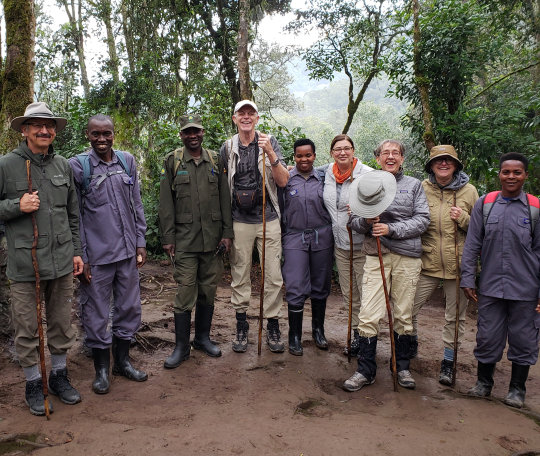
Aided by guides, trackers, and two men who carry semi-automatic rifles, I wearily trudge, scale, and stumble my way up the mountain for what seemed like ages, but was really about an hour and a half, before arriving at the place that would be our view point for the next hour or so. I was exhausted. I wanted to drop to the ground, raise my flag to surrender, and wheeze my way back to normal oxygen levels, but then I saw something incredible. There they were, right in front of us, frolicking, tumbling end over end in a playful, albeit not so gentle, wrestling match, and in that moment all my pains left me.

Photo by Terry Kellogg
Before us was a family of mountain gorillas: the silverback, two females, and three offspring. Two brothers, a year or two apart in age, stayed close to one another, while a third older offspring hung with papa. The gorillas have been habituated for tourism and research, and this has made it possible for us to get so close to these beautiful mammals.
Mostly, they eat vegetation, but they are omnivores and munch on insects and larvae, too. Watching them is extraordinary, as they tumble around on the forest floor, pounding their chests from time to time, nibbling on this and that, and then taking turns picking pesky insects off each other in a you-scratch-my-back-and-I’ll-scratch-yours style nurture and support network. We really are cut from the same cloth. I love their brown eyes, as they casually glance up at us. It’s difficult to estimate, because mostly he just lazily rolled around on his back, but the giant silverback had to weigh upwards of 200 kilograms and, surely, he stood 1.5 meters tall.

Photo by Terry Kellogg
Although their exact population is unknown, it’s around 800, and they’re listed as critically endangered. Over the years, conservation efforts to safeguard the great apes have improved their numbers, but with a long way to go it continues. In 1991, the forest became a national park and fell under the newly founded government body called the Uganda Wildlife Authority, whose responsibility is to regulate wildlife conservation in Uganda. There are several other organizations and individuals whose efforts in whole or part help to protect the gorillas: International Gorilla Conservation Programme, Mountain Gorilla Conservation Fund, Dian Fossey Gorilla Fund, African Wildlife Foundation, and others, as well as the park’s rangers, independent guides, and trackers whose mission is to protect and support the mountain gorillas and their habitat.
As we bid farewell to the Bwindi Impenetrable Forest, we’re sad to leave, but we have a plane to catch. Now, it’s off to the Serengeti. I know I speak for all my friends when I say, we loved this experience, we learned a lot, and we’ll never forget it.
0 notes
Text
Pacific Northwest: Eugene, OR
A Travel Journal Series
By Bonnie Kellogg
“A Great City for the Arts and Outdoors” is Eugene’s slogan. That’s right up my alley. But so is the Market District of this city. The Fifth Street Public Market has a wonderful collection of unique retailers, bustling eateries, including a place called Provisions Market Hall, and a charming inn attached to the marketplace.
Shopping: There are a several shops here that would joyfully fill an afternoon. Among them, Newtw!st offers beautiful designer jewelry, handmade pottery, and gorgeous home décor. I was excited to find a garland of Christmas bells for next year’s tree. Pendleton Woolen Mills sells luxurious pure virgin wool clothing and blankets. As the name suggests, Made in Oregon only carries products that are, well, made in the lovely state of Oregon, including wines, cheeses, nuts, chocolate, and much more. There’s an accessory and needlework shop called Mindy’s, as well as a dozen more shops, including several clothing boutiques, a toy store, a spa and salon, and an alterations/tailor shop.
Restaurants & Specialty: The Fifth Street Public Market has a marvelous assortment of restaurants that will satisfy whatever craving you have: Greek, ramen, sushi, thai, burgers and pizza, baked goods, salads, cheeses, and breads, plus a tasting room called Sweet Cheeks. Love it!
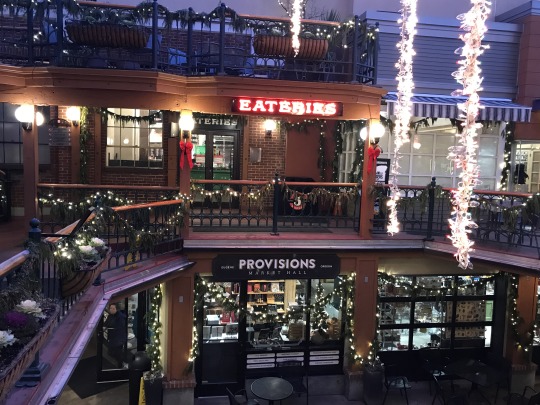
0 notes
Photo
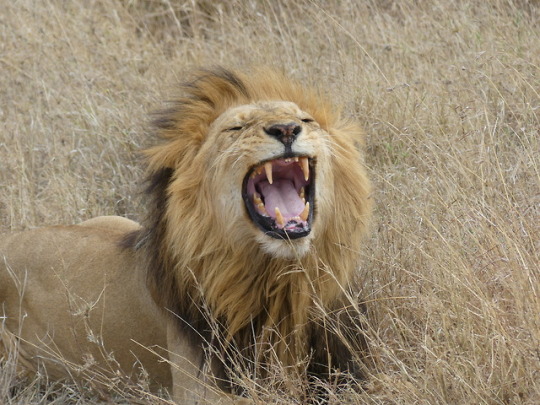
Serengeti
1 note
·
View note
Photo
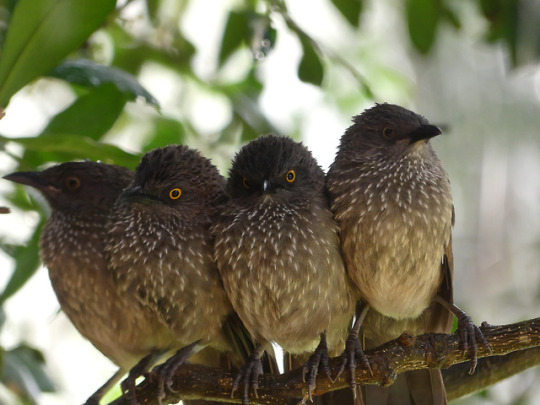
Ashnil Mara Camp - Kenya
2 notes
·
View notes
Text
Oh Canada, You Go Girl!
A Travel Journal Series
By Bonnie Kellogg
On her 150th birthday, I thought I’d write about a few things that I love about my country. I’m pretty sure I did this exact exercise back in the fifth grade, so it’s been a while and long overdue.
She’s Green: I’m not referring to conservation and green politics here. Rather, I’m talking about her abundance of parks and nature that span the entire country from coast to coast. In a world that is seeing ever shrinking green space give way to concrete jungles, with steel and glass towers replacing trees, I love that I can still walk out my door and be in a park or even a forested wilderness within minutes. No plane rides or booking off holiday time necessary to enjoy nature. Yep, we’re geographically lucky. Now, that’s good for the soul. Come to think of it, it’s good for the environment, too!
She’s Welcoming: What is Canada if not a melting pot of diversity? I grew up with kids whose nationality and ethnic backgrounds span the planet and religious spectrum. With an increasingly protectionist movement spreading across the globe, I’m proud that we don’t give in to that sentiment. Period.
She’s a Land of Plenty: Milk and honey? You betcha! At 23-years-old, and without the educational background to bolster my chutzpuah, I thought nothing about starting a business. It simply didn’t occur to Terry and me that we couldn’t do it. Furthermore, we weren’t met with any unmanageable obstacles or unattainable financial requirements, we simply had to work hard and meet any challenge head on. So, it really is saying something that this year, after 27 years of running our business, we proudly and happily pass the torch to people with the same opportunities we had, copious amounts of energy, and fresh ideas to carry our baby into the future. Thanks Canada. Oh, and Happy Birthday!

Canada, eh!
1 note
·
View note
Text
Port Townsend, A New View
A Travel Journal Series
By Bonnie Kellogg
When we drove off the Washington State Ferry and into the small seaside city of Port Townsend last summer, I fell in love with the setting immediately. It gave me that warm, fuzzy feeling that only a place that connects so completely with my soul could do. It has to be one of the coolest towns I’ve ever laid eyes on. Quaint Victorian architecture is peppered against a backdrop of lush landscape. I was so enchanted by its artsy vibe and small town ambience that I knew one day—in the very near future—I would return. There was no doubt about that. Eight months later, on a cool spring weekend in May, that glorious day arrived. Oh joy!
Once again, we’ve come to visit our friends, Gordon and Virginia, who recently made a more permanent commitment to Port Townsend by the purchase of a home. We caught up over dinner and an evening of dreaming and scheming about the future, as is often the case when we get together. Tucked in the corner of Lanza’s Ristorante, over pasta and wine, we chat. What to do when we retire dominates the conversation, and we ask each other the same old questions: How will we fill our days? What places are on the travel bucket list? Where will home base be? These are not terrible problems to have.
The next morning we head out for pastry and coffee. And because one delicious eatery isn’t enough, we walk to two different bakeshops for sweets and caffeine. It’s Mother’s Day and all the cafés and breakfast joints are full to the rafters so we take ours to go. Having rained overnight, the air is damp and fresh as we walk through the streets and into a neighborhood park. I’m hoping the weather will clear up because Gordon has offered to take us on a flight in his new airplane, and I am excited about the adventure.
By mid morning the sky has improved but is still mixed with clouds and spots of rain. We decide the weather is as good as it is likely to get and so we head to Jefferson County International Airport.

I’m told the plane is a Piper PA-28 Cherokee 140 that has been souped-up to a 160. There isn’t a traffic tower at Jefferson, so Gordon announces over the radio, into the airway, our intentions to take off as we taxi to the end of the runway. I’ve flown lots of times over the years, but it feels different in a small aircraft than it does in a massive commercial jetliner. It’s thrilling as we accelerate and then lift into the sky, ascending to our flying altitude of 1500 feet. We bank left and fly by historical downtown Port Townsend over the water and carry on in a northwest direction.

The bird’s eye view of Port Townsend is gorgeous. Houses dot the lush landscape, and I see the small Chetzemoka Park that we’d strolled through earlier that morning. Across the water on Whidbey Island is the point at Fort Casey, one of three forts built—along with Fort Worden in Port Townsend and Fort Flagler on Marrowstone Island—in what is called the “triangle of fire.” The forts were built in the 1890s to protect again an attempted invasion by sea. As we go further out, we can see the San Juan Islands to the north and the city of Victoria, B.C. to the northwest. The view is beautiful. After a short flight, we turn around, return to Jefferson Airport, and land.
We cap off the morning with lunch at the Spruce Goose Café, which overlooks the runway. We watch small planes come and go while we enjoy our meal, and then Terry and I drive to the ferry that takes us back to Coupeville and then home to Vancouver. It’s been a fun weekend. Until next time, Port Townsend!
Photos by Bonnie Kellogg
1 note
·
View note
Text
In the Pursuit of Leisure
A Travel Journal Series
By Bonnie Kellogg
After Disneyland, Palm Springs may well be the second happiest place on earth. The desert city, neatly tucked in the Coachella Valley and framed on three sides by mountains, is a playground for adults, with its golf courses and tennis courts, swimming pools and afternoon cocktails, restaurants and nightclubs, casinos and show lounges. Add the 300+ days of sun annually and favorable temperatures year-round and you’ve got yourself, well, Disneyland for grown-ups.
I love the laid-back feel; nobody has anywhere they need to be, apart from perhaps getting to a dinner reservation or a scheduled tee time. Dilly-dallying, people stroll the streets chatting and popping in and out of shops. It took me a bit to pump the brakes and slow down. I had to make an effort to stop myself from speeding past people on the sidewalk as though I were late. But soon enough my step slowed, and I adopted a more relaxed pace. I could get used to this, I quickly realized.
I was lucky enough to catch Modernism Week, with a trip to the Palm Springs Art Museum, Architecture and Design Center as well as taking a tour of Sandcliff Garden Apartment Homes, built in 1960. The tour consisted of a visit to four homes, all with the same layout that have been refurbished and decorated in different styles. It was an enjoyable excursion and a nice way to spend an afternoon. If you’re a lover of mid-century and can’t make it to Modernism Week, Palm Spring is chock-a-block full of beautiful mid-century modern architecture. You can simply walk through one of any number of neighborhoods and see lots of examples of homes from the era.

Mid Century Modern, Palm Springs (Photo not my own)
I’m happiest when I can sightsee on foot. At home, I walk the busy city or through lush, overgrown trails in the rainforest, so the desert setting was new to me. At times, it felt as though I were walking on another planet. The arid landscape is surprisingly peaceful and quite effective at uncluttering the mind. We spent a day walking in Joshua Tree National Park, with its yuccas, sand-colored rock formations, and big blue sky. What a beautiful slice of America, calm and undisturbed.
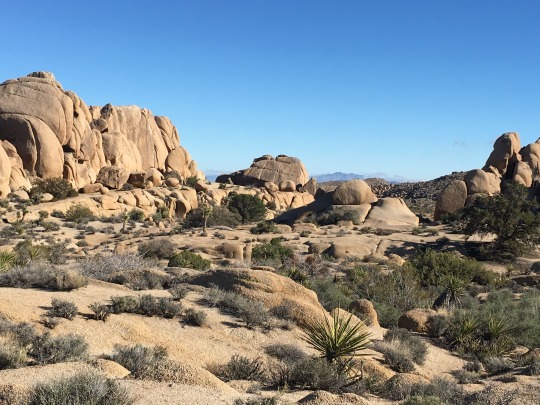
Joshua Tree National Park
We also visited the Living Desert, a combination zoo and botanical gardens, where the flora and fauna are divided into two distinct continents: North America and Africa. As you make your way through, you need to keep your eyes peeled to spot some of the animals as the zoo’s design is meant to mimic their wild habitat and, as would be the case in nature, they’re often hiding in plain sight. Desert plants are all around, with selected areas to showcase certain species as well as being incorporated within the animal enclosures. It’s very well done. They have desert cats; mountain lions and bobcats, as well as cheetahs that demonstrate their speed prowess in a show as they race from one handler to another accepting rewards at both ends. There are canines, including the North American wolf and Africa’s fennic fox. The Living Desert is home to the very rare slender-horned gazelle as well as addax, a type of antelope that lives in the Sahara Desert. They have loads of bird species and a whole section of geckos and other reptiles, not to mention the ant lab. Plus, for a small fee you can feed the “Kellogg family.” Not my family, of course, but the family of giraffes in the Living Desert who are named the Kelloggs!
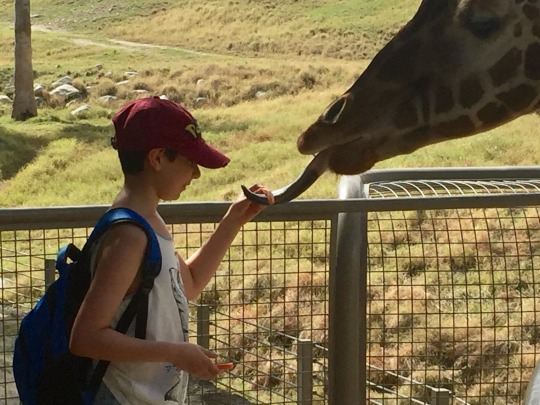
My nephew, Noah, feeding one of the Kelloggs
In between lounging at the pool and going out for ice cream we took one more excursion. On our second to last morning in the desert, we decided to take the Palm Springs tram—the world’s largest aerial tramway—to the top of San Jacinto Mountain and check out the view. Maybe take a short hike through some of the 14,000 square miles of trails?

Palm Springs Aerial Tramway
We made no special provision and wore the same clothing we would on any other day in Palm Springs, oblivious to the fact that we were traveling from the hot Sonoran Desert at 2643 feet to alpine forest at 8516 feet. It was freezing up there! What were we thinking?
After getting past the embarrassment of our blunder, and then trying to make it seem as though we’d planned it all along—crazy Canadians—we decided to brave the outdoors and take a short walk. It lasted precisely five minutes before we turned around. We decided to grab a bite to eat in the restaurant and enjoy the mountain terrain through the window instead. The food was average, but the temperature was comfortable and the view perfect.
After many years of rejecting the idea of going to Palms Springs, it turns out, we enjoyed the trip so much that less than one week into returning home we’ve begun making plans to go back. Maybe we’ll stay longer next time. Meet you at the pool!
Photos by Terry & Bonnie Kellogg
0 notes
Photo
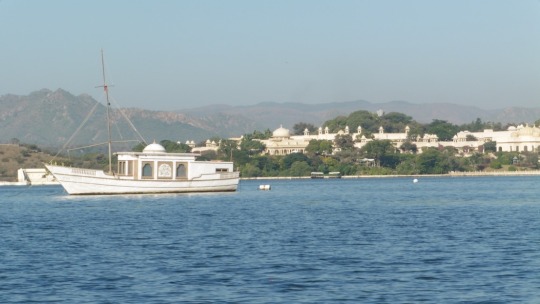
Photo by Bonnie Kellogg
0 notes
Text
To Tour or Not to Tour
A Travel Journal Series
By Bonnie Kellogg
When I consider the aspects of travel that I most enjoy, reasons why I get on a plane as often as I can and transport myself to places unfamiliar, I conclude that my motives are threefold: First, I enjoy breaking away from the daily grind and crave new experiences. Second, I learn so much! One of the best things about traveling is how it changes your point of view and expands your perception of the world. Finally, and most true to form, I have wanderlust.
My usual means to satisfy wanderlust is to simply go somewhere—anywhere—and quite literally stroll around, exploring at my whim and leisure. So when my friend, Virginia, had the idea of going on a trip to India, a place I’ve wanted to see for sometime, I said yes before we worked out any of the details. Then she told me she had already looked into tours. Having never gone on a tour, and given my MO when it comes to traveling, I was a bit uncertain if that was the way to go. We discussed itineraries and, ultimately, concluded it was the perfect method of travel for two females whose goal was to see as much of the country as possible in a couple of weeks.
Upon arriving in Mumbai, it becomes apparent to me at once that there will be no easing into the place, no dipping my toe in the waters to test its temperature before diving in. Rather, I’m pulled straight into the vortex that is India and its 1.3-billion populous.
Broken down, the country is comprised of warm people, vibrant colors, aromas of varying appeal, confronting poverty, hypnotic architecture, a vast history, and captivating spirituality. India, it seemed to me, was bursting at the seams. It’s too much, all at once, when you’re not used to it. But, as it turns out, it would be a good initiation for the days to come. It was time to leave on our first organized excursion, and this frenetic energy would carry over to the tour itself — a tour that I dubbed the Fast & Furious Tour of India.
It takes us to six different cities and a national park where we go on safari. After Mumbai, we travel to Udaipur, Jaipur, Agra, Panna National Park, Varanasi, and Dehli. In each city we visit the sights that draw the usual masses; museums, palaces, forts, places of worship, parks, and in Agra, the most famous of monuments: The Taj Mahal. Incredible! We take three flights, two long coach rides, and a train ride. We arrange wake-up calls, keep our bags organized and ready to go, and seem to have a strictly regimented timeframe at each locale. The tour is, well, fast and furious, as I’ve said.
When at last I reach my hotel, I take a few minutes to decompress before joining Virginia on the pool deck for a cocktail. One last respite before we set out on our journey. The next day we meet our guide and fellow travel companions and then set off on a city tour, where even a simple bus ride turns into an epic adventure. Driving on the streets of India is an art form, and not for the faint of heart.
We see the contrast between the affluent and the needy throughout our tour—you can’t miss it—from the slums and Dhobi Ghat to South Mumbai’s multi-million dollar properties. Disparity abounds. As always, the architecture draws me in. My favorite was the spectacular Gothic beauty Chhatrapati Shivaji Terminus (formerly known as Victoria Train Station), with its stone domes, turrets, and multiple decorative arches.
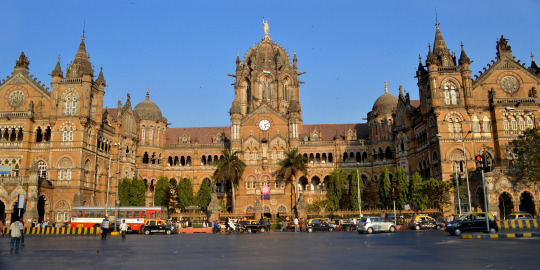
Chhatrapati Shivaji Terminus, Mumbai
We visit the Prince of Wales Museum and then Mani Bhawan, a guesthouse turned museum, dedicated to the life and works of Gandhi. The next day it is a boat trip to Elephanta Island, the carved rock archeological site constructed in the mid-5th century and into the 6th. Then we’re off to the state of Rajasthan and the picturesque city of Udaipur.
We putt along Lake Pichola to our accommodation, the gorgeous Lake Palace Hotel, which is situated in the center of the man-made fresh water lake. The rulers of the day used this palace as their summer home. I fell in love with it at first sight: its marble architecture, lush courtyards and fountains, and scenic view over Udaipur. What a place!
The next day we tour the City Palace, built by Maharana Udai Singh and his successor Maharanas over the next 400 years.

Pichola Lake, Udaipur
On our last day in gorgeous Udaipur we visit two temples, Eklingji, dedicated to Shiva, and the deserted temple called Nagda, constructed in honor of Lord Vishnu.
Our whirlwind travel itinerary speeds along to the state capital, the famous pink city, Jaipur. Here we tour two sections of the City Palace: the Mubarak Malal, which displays a good collection of textiles, including costumes worn by the royal family as well as Kashmiri pashminas and silk saris, and then Hawa Mahal, know as Palace of the Winds.
Built next to the women’s chambers in the City Palace, this unique 5-storey sandstone structure, with its 953 windows patterned with intricate lattice work, was built to allow the royal ladies to view the streets below without being noticed.

Palace of the Winds, Jaipur
After, we’re whisked off to Amber Fort and the gardens at Amber Fort. The reddish-pink sandstone structure, adorned with intricate doors and windows, is laid out on four levels, each with its own courtyard. It was built on the hill above the town of Amer, just outside of Jaipur, and served as home for the Rajput Maharajas and their families. It’s a gorgeous view up here and an interesting site to visit.
The next morning we leave Jaipur and spend the day driving to the most celebrated symbol of love in the world, the Taj Mahal. Now, I’m not one of those women who fall over themselves upon hearing a story about undying affection, but this one is rather special and even I can appreciate the sentiment behind it. As always, though, it’s the architecture that has me most intrigued; the four pillars at each corner of the structure, the marble arches, the perfectly round central dome, topped with the sacred Hindu pinnacle, and the marble inlay ornamentation. It’s beautiful!
Lighting is everything, we’re told. In keeping with that theory, we make our first visit to the site in late afternoon as the sun is setting over Agra. The ivory-white marble glistens under the sun. I expect that some of the glints of light come from the 28 different kinds of rare stones and metals used in the inlay details of this stunning monument. We make our second and final visit to the Taj Mahal at sunrise the next morning. The verdict: it’s just as beautiful as it was at sunset.
Our last item on the agenda is a visit to the Agra Fort before catching our train the following morning and setting off to our next destination, Jhansi and into the Panna National Park. We board a coach and are given fair warning that the ride will be a rough one; the monsoons have washed out a stretch of the road, turning our luxury coach trip into a long amusement park ride. We arrive and check into our remote wilderness accommodations, a little green around the gills but otherwise intact.
The next morning, after a good night’s sleep and a hearty breakfast over excited chatter about the day to come, we eagerly head out on safari in hopes to spot the forest’s top predator, the Bengal Tiger. Despite Panna National Park being declared as one of the tiger reserves of India in 1994 and it falling under a National Protection Act entitled Project Tiger, by 2009 the entire tiger population had been wiped out by poachers, and it had been done with the collusion of the very forest department officials hired to watch over them. In the years since, efforts have been made to replace the population by relocating tigers from other reserves around the country. Altogether, four tigers (two male and two female) were relocated, established their territory, and bore cubs, bringing the population to 14 in total.
After a couple of hours on safari, we have seen a number of animals, including the Sambar and Spotted Deer, gazelle, the small jungle cat known as the Caracal, vultures, and a number of exotic bird species. As the day comes to an end, it’s becoming less likely we will see a tiger. By sunset all safari jeeps must leave the national park. With just under an hour to go, and despite their low numbers and elusive nature, we get word of a tiger sighting from another jeep. The naturalists communicate its whereabouts to one another. We race across the forest over dirt trails. Several jeeps converge on the cliff’s edge. Everyone jumps out. The naturalist points to the valley below, and then we all squint in the direction of his index finger. Way down, in the gorge beneath us, the tiger lies on a rock by the river, his half eaten meal of what may have been a deer spread on the ground next to him. It’s a long, long way and only those with a better camera lens get a proper photo. We stay for 30 minutes and then it’s time to go. I’m happy to have seen him in spite of the distance.
Next, we travel onto Varanasi and this is where things get rough for me. I actually thought about wrapping up this travel story without ever mentioning what happened at the tail end of my trip, but since its impact affects me to this day, it seemed insincere to omit such a significant event.
As the trip was coming to an end—we had four days left—I abruptly became ill. On the River Ganges I suddenly felt flushed and woozy. I was quick to chalk it up as my reaction to the highly sensitive funeral rituals that were going on around me, but upon my return to the hotel my fever only got worse. Over the next four days, including on a flight from Varanasi to Dehli, I continued to fight a severe fever and nausea. I was lucky to have had travel companions on our tour who were nurses and worked to get my fever down. In Dehli, I saw a doctor who prescribed medication.
When my fever finally broke, I had a short window of time in which I felt just well enough to fly home. After 20 hours of traveling, with my pal, Virginia, who had changed her flight to accompany me, we arrived in Vancouver. I was exhausted and feeling worse than ever so I went into the hospital. After much testing and several weeks back at home and in bed I was diagnosed with a viral tropical fever known as Chikungunya.
Today, six weeks later, I am recovering and well enough to two-finger type this travel story. For my friends, my getting sick seems to have outshone the whole trip. The first thing they want to know is: “Do I regret going to India?”
When I think about all the places we visited, all the sights where we left our footprints, albeit sometimes at a breakneck pace, I’m left with fond memories of the country, its people, and the group that I traveled with on this journey. So when they ask me if I regret having gone, the answer is no. For me, India was an adventure I’m glad I undertook.
I must admit, at times it struck me as strange way to travel, tailing our guide from one locale to the next. But, in the end, I concluded the following: For Virginia and me, an organized tour was the best way to see India. Fitting in all the cities and attractions that we visited in a 16-day period is miraculous, and we could never have achieved that on our own. However, I don’t see myself taking a tour like this again. The pace was too feverish-no pun intended-and the tour too structured. It left no room for spontaneity. In spite of all we did, all we saw and experienced, at my core, traveling to me still means to simply wander. Ah, freedom!
Photos by Bonnie Kellogg
1 note
·
View note
Photo
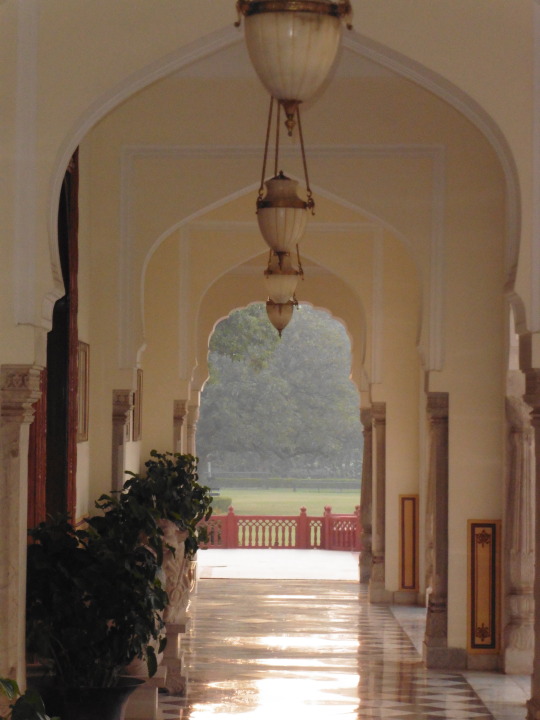
Photo by Bonnie Kellogg
0 notes
Photo
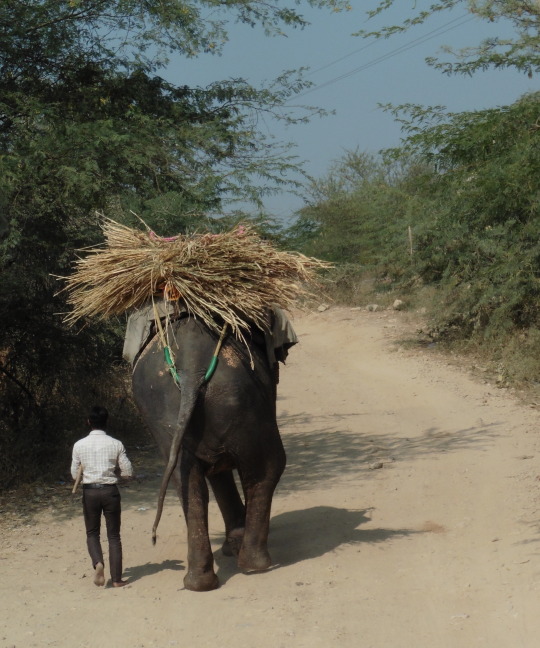
Photo by Bonnie Kellogg
0 notes
Photo
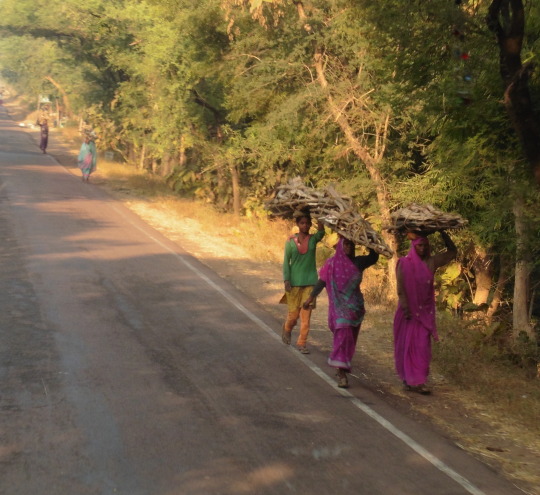
Photo by Bonnie Kellogg
0 notes
Text
Island Time
A Travel Journal Series
By Bonnie Kellogg
I’d always thought the expression Island Time was made up, invented by those who couldn’t keep a schedule if their life depended on it. But that was before I began spending time on Vancouver Island, and then it wasn’t long before I came to understand the true meaning behind the idiom.
Yes, it does refer to pace. But it’s more than just a carefree attitude towards the clock and a slower schedule. It also represents the idea that there are more important things in life than running your tail off, chasing success, and acquiring objects.
It’s ironic, then, that what first brought me to this island was the purchase of an investment property. On a couple of occasions, Terry and I invested in properties and had always been successful in the ventures. But when we took possession of our new condo in Victoria—completed more than a year past schedule—this endeavour would turn out very differently.
The year was 2008, and the economy was suffering. There would be no selling this one straightaway; the idea of flipping the place went down the drain along with the market. But keeping it for the long haul wasn’t in the plans. Eczema bloomed across my arm as I tried to figure out what to do. Our only option, it seemed, was to rent it. So that’s what we did.
After furnishing the two-bed, two-bath condo we listed it as a short-term rental. Luckily, we had no problem getting paying guests and saw it occupied most of the time. We had a retired couple from Alberta, two sisters from Quebec, and lovely family who’d found their way to Victoria after the earthquake and tsunami in Japan had them fleeing their home in 2011. There were short intervals between rentals, so Terry and I began to stay at the condo. And that’s the silver lining of this story.
Running our business in Vancouver is always stressful, so we began to look forward to getting on the ferry and setting off to Victoria. It starts as soon as you board the ship; blood pressure decreases as we stand on the windy deck of the boat inhaling giant gulps of ocean air. We’re already relaxed by the time we’ve parked the car at our condo, where it will sit until it’s time to return to the mainland. We drop our bags off and set out on our customary walk to the grocery store, the start of many walks to come.

Fisherman’s Warf, Victoria
Of course we still work while on the Island—must pay the bills—but we cut the workload down by half. As though it were a force of nature, more leisurely activities are penciled into the day. We walk and talk, try new recipes and wines, read and write, and in Terry’s case, pick up one of his guitars and play old 70s and 80s songs. So that’s what those things are for!
A couple of years ago, we stopped renting the place out; lodgers were getting in the way of our staying there. Today we divide our time almost fifty-fifty between the fast tempo of Vancouver and the laid-back pace of this island home.
Now I get it: Island Time refers to time well spent in a place that recharges the batteries, purifies the soul, and rebalances your priorities. Sign me up!
0 notes
Text
Port Townsend
A Travel Journal Series
By Bonnie Kellogg
We get our first glimpse of the small picturesque seaside city as our ferry approaches its landing place. We’ve traveled from Vancouver to Whidbey Island, and from there it’s a quick thirty-five minute trip from Coupeville across a windy passage and into Port Townsend Bay.
Perched on the northeastern tip of the Olympic Peninsula, this Victorian seaport is a stunner.

If I could only choose three things to write about Port Townsend—good times spent with friends not included—I would have say that I am most delighted about the following:
It’s artistic.
Within hours of setting foot here, I already know I will return someday. There’s just something about the place. A feeling. Largely a haven for retirees, I have the impression that people arrived in Port Townsend after a lifetime of earning a living elsewhere and now they are doing what they’ve always wanted to do. They paint and write. They carve sculpture and spin clay. They tend to visitors in their quaint guesthouses, and they run art galleries and small shops. There’s even a cool classic autos and memorabilia shop that is clearly a place of pleasure for its owner. They don’t do it because they have to; they do it because they want to. And they love it.
It’s this artsy vibe in the community that has enchanted me, so I am thrilled to learn they have their own annual writer’s conference. It’s a wonderful surprise that has reinforced my desire to return, and I hope to attend the conference in the future.

It’s walkable.
I’ve said it before, I know, but I think there’s no better way to sightsee than doing so on foot. And this is the perfect place to do just that. Lined with interesting shops, restaurants, and historical buildings, downtown is comprised of a handful of streets that make for an easy, comfortable walk.
A boater’s paradise, the marina and wharf area is especially large for a locale of this size. It’s a nice spot to take a stroll. There’s a good selection of waterfront restaurants to grab a bite of lunch or to just kick back with a cup of coffee and watch sailboats come and go. We spend a lot of time here.
A couple of blocks above downtown is an area known as Uptown. Similar to the main streets of downtown, Lawrence Street has shops, restaurants, and the famed Aldrich’s Market, the oldest grocer in Washington State. As well, twice a week in the spring and summer months merchants display their goods for sale at the farmer’s market. We buy some crusty bread, cheese, and wine to enjoy later, and a cinnamon bun to share on the walk back to our lodgings. And that brings me to my third thing:
It’s charming accommodations.
There are loads of places to stay, no less than twenty guesthouses and inns and nearly as many hotels and motels. There’s even a castle. Built by the first mayor and pioneer of Port Townsend, Charles Eisenbeis, it was constructed in 1892. I was having a difficult time choosing—should I pick a castle or one of the inns?—and then I saw her and my choice was made. The Ann Starrett Mansion sits atop a hill, overlooking the town below. George Starrett built the Queen Ann Victorian in 1889 for his beloved wife and the inn’s namesake. It is said to be haunted. And at the risk of Terry rolling his eyes at me, I believe it!

There are eight unique guest rooms, each beautifully decorated with lovely antiques. We stay in Ann’s Parlor, with its cozy canopy bed and rocking chair. I wrote most of this blog on that chair! It is the only room with its own balcony and view of beautiful Puget Sound. And in spite of the punishing heat outside, the room was cool and comfortable. See, ghostly. ;-)
After our short stay, we’re off to Port Angeles to board another ferry, this one destined for Victoria, B.C., my regular stomping grounds when I’m not in Vancouver. It was a fantastic introduction to a place that I didn’t expect to enjoy so much. I can’t wait to return, maybe sooner than I imagined.
0 notes